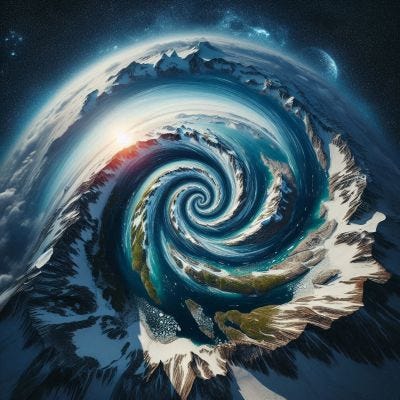On April 3, flanked by the outgoing and incoming prime ministers of Greenland, the Danish leader, Mette Frederiksen, reiterated that “you cannot annex another country”. This was not a message sent to Russian president Vladimir Putin, but to Donald Trump, the president of one of her country’s closest allies, who has threatened to take over Greenland.
Frederiksen, speaking in Greenland’s capital Nuuk, was stating something that is obvious under international law but can no longer be taken for granted in international politics. US foreign policy under Donald Trump has become a major driver of this uncertainty, playing into the hands of Russian, and potentially Chinese, territorial ambitions.
The incoming Greenlandic prime minister, Jens-Frederik Nielsen, made it clear that it was for Greenlanders to determine their future, not the United States. Greenland formally became part of Denmark under the terms of the 1814 Treaty of Kiel, first as a colony and in 1953 as a province. Since 1979, it has enjoyed a large degree of autonomy.
Polls suggest a majority of islanders want independence from Denmark in the future, but don’t want to be part of the US. As Nielsen put it in response to Marco Rubio, Trump’s secretary of state, “He is not right that Greenland wants to secede tomorrow. He is right that Greenland does not want to be Danish, but Greenland certainly doesn't want to be American either."
Trump’s interest in Greenland is often associated with the island’s vast, but largely untapped, mineral resources. But its strategic location is arguably an even greater asset.
Trump’s interest in Greenland is often associated with the island’s vast, but largely untapped, mineral resources. But its strategic location is arguably an even greater asset. Shipping routes through the Arctic have become more dependable and for longer periods of time during the year as a result of melting sea ice. The northwest passage (along the US and Canadian shorelines) and the northeast passage (along Russia’s Arctic coast) are often ice free now during the summer.
This has increased opportunities for commercial shipping. For example, the distance for a container ship from Asia to Europe through the northeast passage can be up to three times shorter, compared to traditional routes through the Suez Canal or around Africa. Similarly, the northwest passage offers the shortest route between the east coast of the United States and Alaska. Add to that the likely substantial resources that the Arctic has, from oil and gas to minerals, and the entire region is beginning to look like a giant real estate deal in the making.
The economic promise of the Arctic, and particularly the region’s greater accessibility, have also heightened military and security sensitivities.
On March 27, the day before JD Vance, Trump's vice president, visited Greenland, Vladimir Putin gave a speech at the sixth international Arctic forum in Murmansk in Russia’s high north, warning of increased geopolitical rivalry. While he claimed that “Russia has never threatened anyone in the Arctic”, he was also quick to emphasise that Moscow was “enhancing the combat capabilities of the Armed Forces, and modernising military infrastructure facilities” in the Arctic.
Equally worrying, Russia has increased its naval cooperation with China and given Beijing access, and a stake, in the Arctic.
Equally worrying, Russia has increased its naval cooperation with China and given Beijing access, and a stake, in the Arctic. In April 2024, the two countries’ navies signed a cooperation agreement on search and rescue missions on the high seas.
In September 2024, China participated in Russia’s largest naval manoeuvres in the post-cold war era, Ocean-2024, which were conducted in north Pacific and Arctic waters. The following month, Russian and Chinese coastguard vessels conducted their first joint patrol in the Arctic. Vance, therefore, has a point when he urges Greenland and Denmark to cut a deal with the US because the “island isn’t safe”.
But this is hardly Denmark’s fault alone. The US airbase in Pituffik currently hosts some 200 American personnel — during the Cold War, the US maintained some seventeen installations on the island with 10,000 soldiers, according to Denmark’s foreign minister, Lars Lokke Rasmussen. Moreover, the 1951 Greenland Defence Agreement between Denmark and the United States and its amendment in 2004 grant Washington substantial rights in the island. This was further supplemented during the first Trump administration with a “Common Plan” to enhance cooperation between the US and Greenland, and even Project2025 merely recommends that “the next administration should pursue policies that enhance economic ties between the US and Greenland.”
Yet, it is not just the United States that is now more concerned than ever that the Russia-China partnership has resulted in an increasingly military presence in the Arctic.
Yet, it is not just the United States that is now more concerned than ever that the Russia-China partnership has resulted in an increasingly military presence in the Arctic. Worried about the security of its Arctic territories, Canada has announced a C$6 billion (£3.2 billion) upgrade to facilities in the North American Aerospace Defense Command it operates jointly with the United States. It will also acquire more submarines, icebreakers and fighter jets to bolster its Arctic defences and invest a further C$420 million (£228 million) into a greater presence of its armed forces.
Norway has similarly boosted its defence presence in the Arctic, especially in relation to the Svalbard archipelago (strategically located between the Norwegian mainland and the Arctic Circle). This has prompted an angry response from Russia, wrongly claiming that Oslo was in violation of the 1920 Svalbard Treaty which awarded the archipelago to Norway with the proviso that it must not become host to Norwegian military bases.
Under Article 3 of the treaty, Russians — and nationals of any other signatory — have a right to commercial activities there. Until 1998 Russia operated a coalmine in Pyramiden, but today only maintains a presence in Barentsburg. The town is owned by the Russian mining company Trust Arktikugol, but has gradually evolved from a coal mining operation into a hub for tourism and research. The town also hosts a Russian research centre, established in 2014, which includes a satellite ground station.
Despite its relatively minimal presence, Moscow is keen to protect what it considers its rights and national interests in Svalbard. For this purpose, it established a “commission on ensuring Russia’s presence on the archipelago Spitzbergen”, the name Moscow uses for the archipelago, which is chaired by Russian deputy prime minister Yury Trutnev, who is also Putin’s envoy to the far eastern federal district. This is not the most active of Russian government commissions, but Trutnev has repeatedly complained about undue Norwegian restrictions on Russia’s presence in Svalbard, as has the Russian foreign ministry, for example in 2021, 2022, 2023 and 2024. Oslo has rejected these criticisms, as well as more recent persistent claims in 2024 by Moscow that it was militarising the archipelago.
From the Kremlin’s perspective, this is partly about Russia’s historical rights on Svalbard but more about Norway’s – and Nato’s – presence in a strategic location at the nexus of the Greenland, Barents and Norwegian seas. From there, maritime traffic along Russia’s northeast passage can be monitored. If, and when, a central Arctic shipping route becomes viable, which would pass between Greenland and Svalbard, the strategic importance of the archipelago would increase further — for both Russia and the west.
From Washington’s perspective, Greenland is the more important of the two islands because of its closer proximity to the US. But Svalbard is critical for monitoring and countering Russian, and potentially Chinese, naval activities in the region where the Arctic and the north Atlantic meet. This bigger picture tends to get lost in Trump’s White House, which is more concerned with its own immediate neighbourhood and cares less about regional security leadership.
Consequently, there has been no suggestion — so far — that the US needs to have Svalbard in the same way that Trump claims he needs to have Greenland to ensure US security. Nor has Russia issued any specific threats to Svalbard. But it was noticeable that Putin in his speech at the Arctic forum discussed historical territorial issues, including an obscure 1910 proposal for a land swap between the US, Denmark and Germany involving Greenland. Putin also noted “that Nato countries are increasingly often designating the Far North as a springboard for possible conflicts”. It is not difficult to see how Moscow’s logic could develop here: if the US can claim Greenland for security reasons, Russia should do the same with Svalbard.
The conclusion to draw from this is not that Trump should aim to annex a sovereign Norwegian island next.
The conclusion to draw from this is not that Trump should aim to annex a sovereign Norwegian island next. The maritime geography in the north Atlantic around Greenland and Svalbard underscores the importance of maintaining and strengthening long-established alliances.
Investing in expanded security cooperation with Denmark and Norway as part of Nato would secure US interests closer to home and send a strong message to Russia. It would also signal to the wider world that the US is not about to initiate a territorial carve-up of global politics that upends the existing order and may well suit the interests of Moscow and Beijing in the longer term more than Washington’s.
An earlier version of this analysis was published by The Conversation on April 4, 2025.
We hope you'll share Navigating the Vortex with anyone you think might find it of interest. Also, you can listen to our podcast editions via the website and on all major podcast platforms, including:












